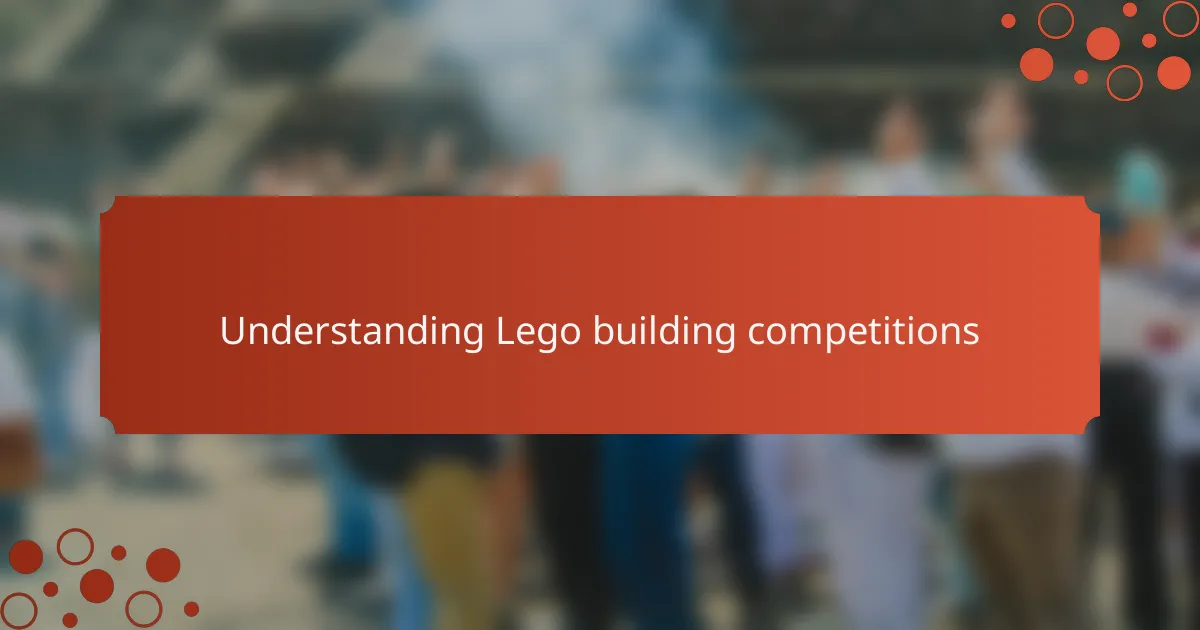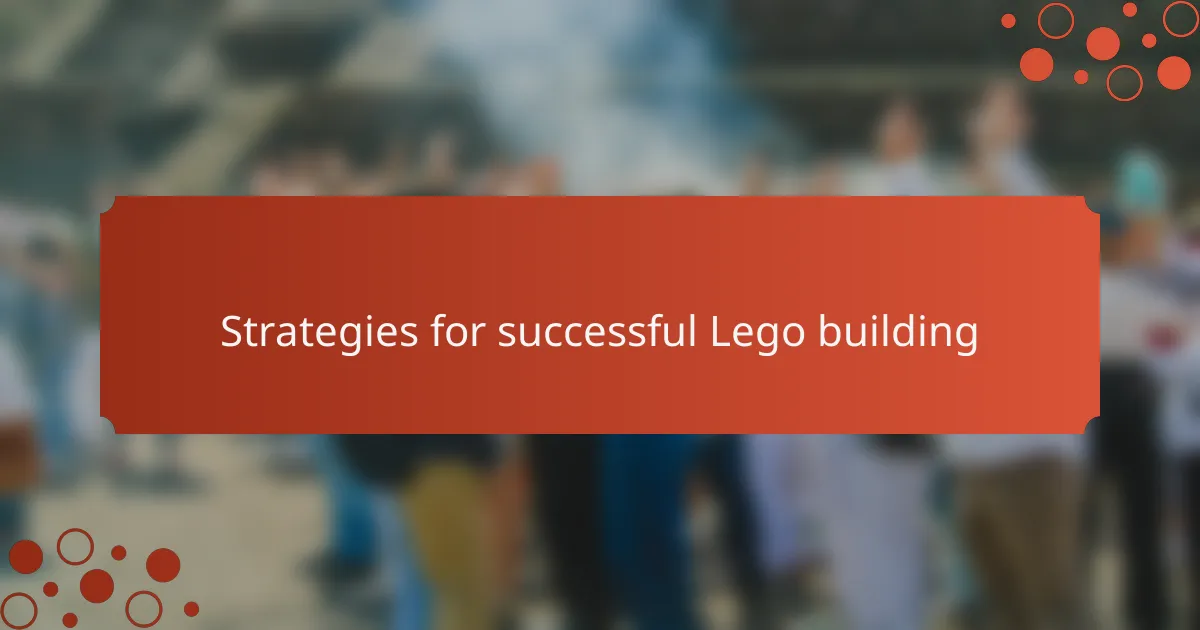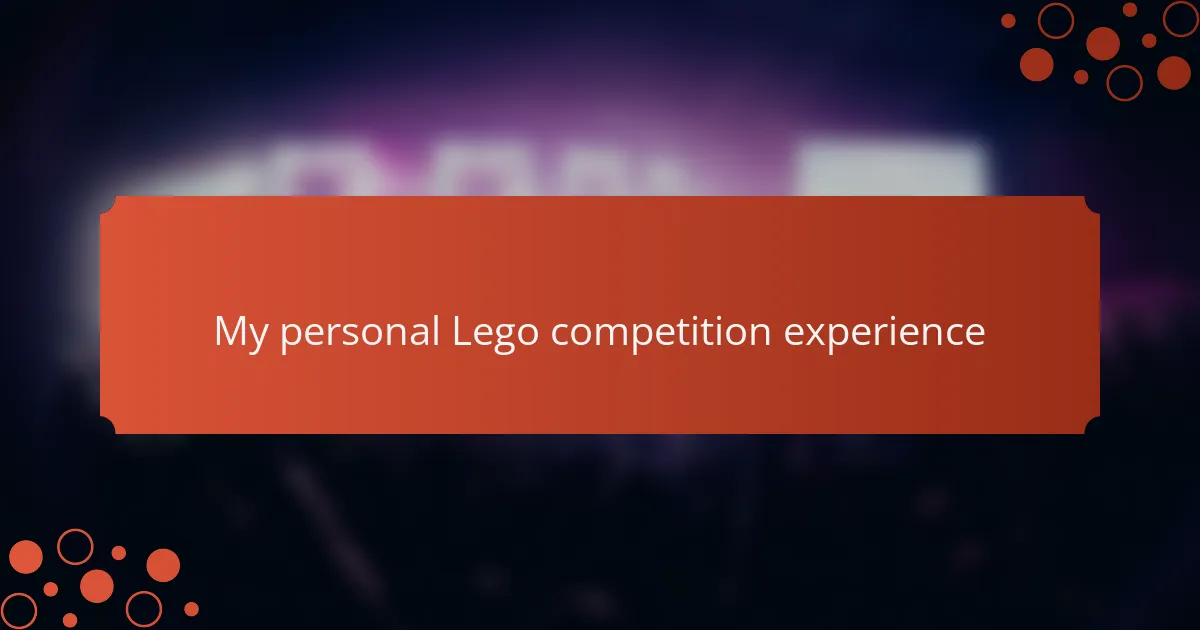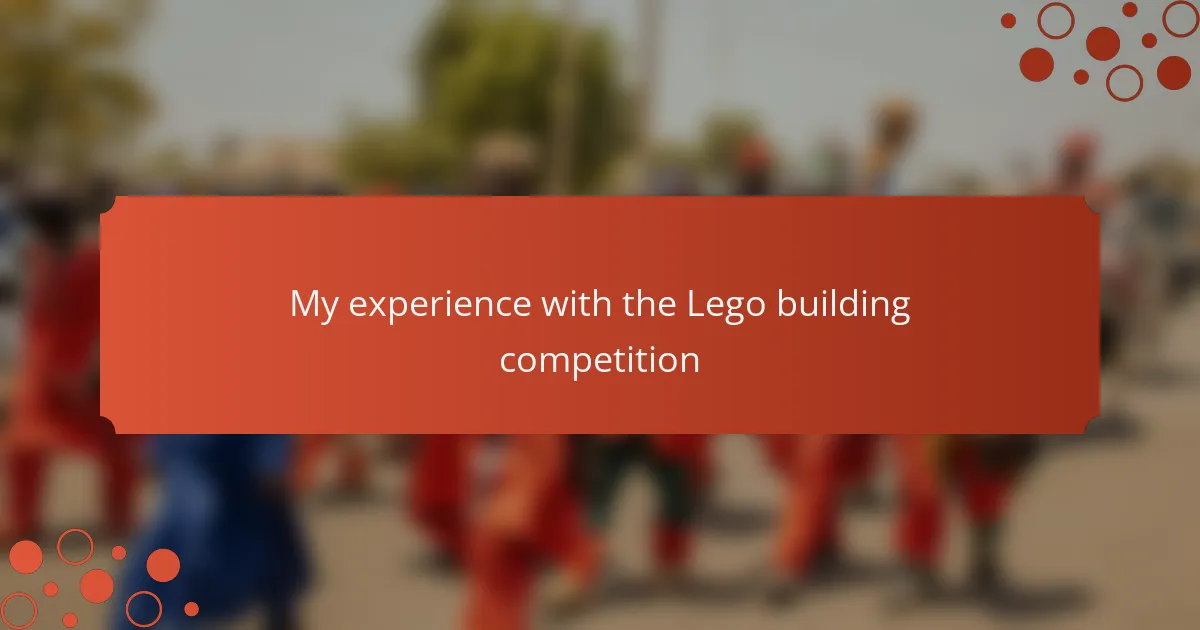Key takeaways
- Video contests foster creativity and community, encouraging unique storytelling through visuals.
- Lego building competitions require a blend of imagination, technical skill, and strategy, highlighting the importance of a solid foundation in designs.
- Participants should plan their builds, focus on organization, and maintain steady pacing to enhance overall construction quality.
- Engaging with fellow competitors can provide new insights and foster a sense of camaraderie, enriching the competition experience.

Introduction to video contests
Video contests have a unique way of bringing creativity to life, don’t they? From my own experience, I find that they turn simple ideas into captivating stories, all through the lens of a camera. Have you ever wondered what makes a video truly stand out in these competitions?
What fascinates me is how these contests encourage people to experiment with different styles and techniques. It’s not just about winning; it’s about expressing yourself in ways you might never have tried before. I remember feeling a mix of excitement and nervousness every time I hit record, not knowing exactly where the journey would lead.
Jumping into a video contest always opens up a new world of possibilities. It’s like being part of a club where everyone shares a passion for storytelling through videos. And that shared enthusiasm? It’s incredibly motivating, pushing me to keep improving and thinking outside the box.

Understanding Lego building competitions
Lego building competitions have a charm of their own that caught me by surprise. At first, I thought it was just about stacking bricks, but it quickly became clear that creativity and strategy play huge roles. Have you ever tried turning a pile of tiny pieces into something meaningful under a time limit? It’s surprisingly intense.
What I found most captivating is how these contests blend imagination with technical skill. It’s not enough to build something cool; you need to think about stability, design, and how your creation tells a story. I remember feeling that rush of excitement when my idea started to take shape, knowing every brick mattered.
The community aspect also stands out. Watching others build with such passion inspired me and pushed my limits. Isn’t it amazing how a simple block can bring people together, igniting both friendly competition and collaboration? That mix of pressure and camaraderie made the whole experience unforgettable.

Strategies for successful Lego building
Getting a grip on successful Lego building comes down to planning your approach before you snap the first brick in place. I’ve learned that sketching a rough design or even just picturing the end result in my mind makes all the difference. Have you ever tried building on the fly? Trust me, having a clear vision saves you from those frustrating moments when your creation feels more like a wobbly mess than a masterpiece.
Another cornerstone for me is focusing on the foundation early on. When I started treating my base like the skeleton of a structure, things suddenly became way more stable and less likely to tumble mid-competition. It’s amazing how much of a difference starting with a solid foundation can make—and frankly, it gave me way more confidence to keep building upwards without second-guessing every piece.
Then there’s the bit about mixing creativity with practicality. Sure, I love experimenting with wild ideas, but I’ve also learned that sometimes simplicity shines louder than complexity. Have you ever felt the thrill of nailing that perfect balance between eye-catching design and structural integrity? It’s like the ultimate sweet spot that keeps both the judges and yourself genuinely impressed.

My personal Lego competition experience
When I first signed up for a Lego building competition, I wasn’t quite sure what to expect. I remember my hands trembling slightly as I faced the pile of bricks, wondering how I could possibly turn those scattered pieces into something meaningful within such tight time constraints. Have you ever felt that mix of excitement and overwhelm, knowing the clock is ticking but your imagination is racing?
Midway through the contest, I hit a frustrating snag when a key section of my model kept collapsing. It was a test of patience and problem-solving, pushing me to rethink my approach on the fly. That challenge taught me more about resilience than any practice session ever could—it reminded me that sometimes the build is as much about staying calm as it is about creativity.
One of the most memorable moments was the friendly chatter and quick exchanges of tips with fellow competitors. There was this unspoken camaraderie; even though we were technically rivals, we shared the same passion. Doesn’t it feel amazing when a simple activity like clicking bricks together can spark connection and inspire you to push your own limits? That sense of community is something I still cherish deeply.

Tips for future Lego competitors
One tip I can’t stress enough is to keep your workspace organized. During my first competition, I underestimated how much time I’d lose digging through a messy pile of bricks. Have you ever found that one crucial piece at the very bottom after wasting precious minutes? Keeping everything tidy helps you stay focused and calm.
Another thing that really helped me was pacing myself throughout the build. It’s tempting to rush at the start, but I learned that steady progress beats frantic scrambling any day. When I slowed down to think things through, my builds were stronger and looked more polished by the end. Have you tried balancing speed with care? That balance can make or break your final piece.
Finally, don’t shy away from asking for advice or sharing ideas with other competitors. I was surprised how much I learned just by chatting with others mid-competition. Sometimes, a fresh perspective is all you need to solve a tricky problem or spark new creativity. Isn’t that part of the fun—growing together while competing?


